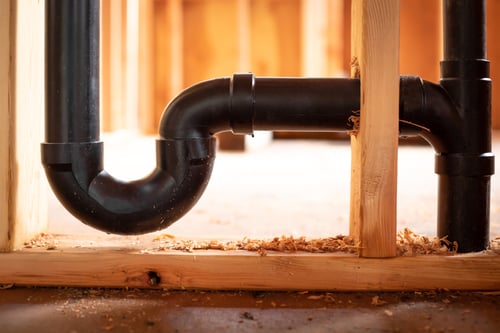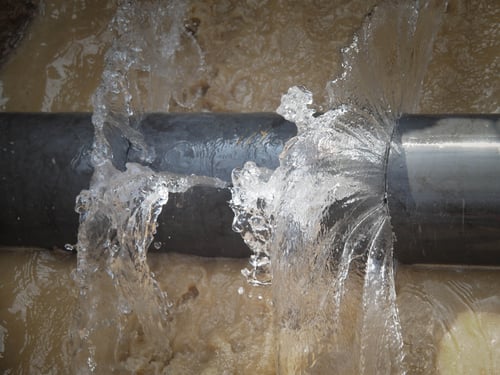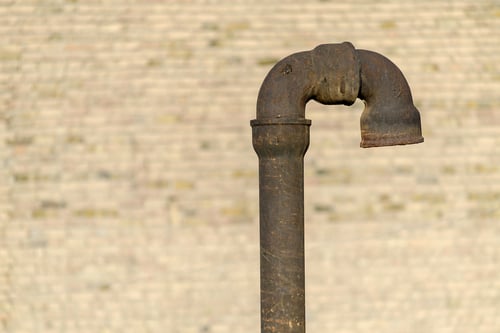Why Are Sewer Gases Escaping from My Drainage System?

The function of a drainage system goes beyond the removal of wastewater from plumbing fixtures. Drainage systems must also be designed to prevent backflow, while keeping sewer gases away from indoor spaces. The term “sewer gas” is used to describe the mixture of gases released by sewage, and individual gases can be toxic or non-toxic.
Many sewer gases are odorless, and the characteristic smell when they leak can be attributed to hydrogen sulfide. This gas is also toxic and flammable, which makes it dangerous in higher concentrations.
There are many ways in which sewer gas can escape from a drainage system, and the specific cause can only be determined with an inspection. This article describes the most common issues and how to fix them.
Get a professional plumbing design for your next building project.
1) Dry P-Traps in the Drainage System

You have likely noticed that plumbing fixtures connect to the drainage system with pipe segments that are shaped like a letter P sideways. This is called a P-trap, and it holds water to create a liquid barrier between the drainage system and indoor spaces.
Since water evaporates over time, the P-trap of a plumbing fixture that has not been used in a long time can become dry. When this happens, the water barrier holding back sewer gas is no longer present, and foul odors can escape.
This issue can be fixed very easily - it is just a matter of allowing water into the P-trap. No plumbing services are needed, and the sewer gas problem can be fixed within seconds. If dry P-traps have been ruled out and sewer gas is still escaping, calling a plumber is recommended. However, it helps to know about the potential issues that may be found.
Note that traps are not only used in plumbing fixtures, but also in floor drains. Even if all fixtures have water in their traps, there could still be a dry floor drain allowing sewer gas out.
2) Damaged Seals or Piping

Plumbing connections use special seals to prevent leaks, and in the case of drainage systems these seals also keep sewer gas inside the piping. In particular, toilets have a wax ring that can be damaged over time, allowing the escape of sewer gas.
Some damaged seals can be detected by observing water leaks, but this is not always the case. Professional plumbers use a smoke test to find leaks - pressurized smoke is injected into the drainage system, and it leaks out through damaged seals.
The drainage piping itself can also be damaged, and this has an effect similar to a damaged seal: sewer gas can escape, and there may also be a wastewater leak depending on the position of the cracked pipe. The smoke test is also effective in this case.
3) Damaged or Blocked Vent Lines

A functional plumbing system not only has drainpipes, but also vent lines. Just like drainpipes remove wastewater, vent lines reach all the way to the roof to release sewer gas outside.
-
Without vent lines, there is no way to stabilize the pressure inside a drainage system.
-
If a drainage system is installed without vent lines, pressure differences can prevent water from flowing in, or they can even cause wastewater to flow back from drainpipes.
A blocked vent line can accumulate pressure, and sewer gas may seep into building areas even when P-traps contain water. Vent lines can be blocked if leaves and debris fall in, or if a small animal climbs in from the roof and dies inside. In both cases, a professional plumber can clear the vent lines to fix the issue.
Consider that vent lines can also be damaged just like drainpipes, and sewer gas can escape through cracks. Plumbers can use the smoke test to detect these trouble spots.
Additional Recommendations
When an indoor space is affected by an unpleasant smell, do not immediately assume you have a sewer gas leak. Mold is another common issue that produces odors, and it can grow on many surfaces when indoor humidity is not controlled adequately.
Mold and sewer gas produce very different odors: while sewer gas is often described as “rotten egg”, mold odors are described as “musty”. Mold can also become a serious problem if left unchecked, since is damages many materials and causes allergic reactions in sensitive individuals. Large patches of mold require the services of a professional remediation company for removal.
When a building has a sewer gas leak, make sure that dry P-traps are ruled out before calling a plumber for reparations - the problem can be fixed by simply filling the traps with water. However, if the drainage system or its vents have been damaged or clogged, they must be serviced by professional plumbers.

Keith Fink
Keith is the Franchise Brand Manager at NY Engineers, Keith is all things related to our project portfolio, brands and all things you need to know before we start your project.
Join 15,000+ Fellow Architects and Contractors
Get expert engineering tips straight to your inbox. Subscribe to the NY Engineers Blog below.
